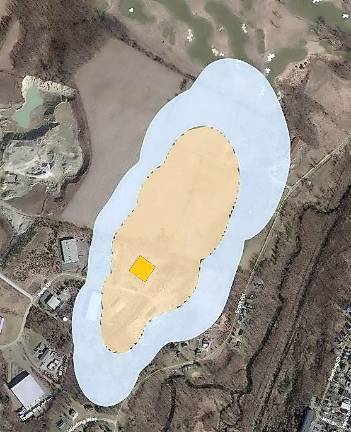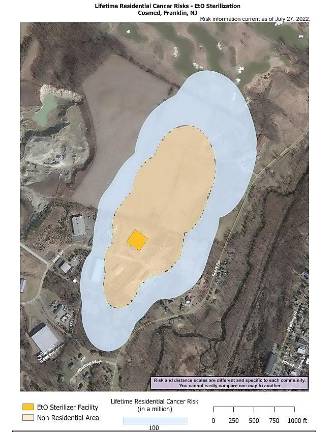‘Elevated cancer risk’ around Park Drive area of Franklin
FRANKLIN. THE EPA recently made the designation after completing a risk assessment.


The area around Cosmed Group Inc., located at 19 Park Drive, Franklin, has been labeled as having an “elevated cancer risk,” due to the company’s emission of ethylene oxide (EtO) to sterilize medical equipment and materials, according to the U.S. Environmental Protection Agency (EPA). The assessment was made after EPA scientists completed a risk assessment to “understand the impact of EtO emissions from the Cosmed Group.”
“As part of this risk assessment, we used the most recent available information about how much EtO the company emits into the air and we modeled estimated cancer risks to people living nearby. The risk assessment identified elevated cancer risk in the Franklin community. EPA is committed to working with state and local agencies, facilities, and communities to reduce this risk,” the EPA said in a recent news release.
The EPA added that it is continuing to collect and verify information about this facility and its emissions, and will update its report if the status changes.
The risk assessment evaluated the cancer risk that could be attributable to EtO, in addition to the risk of developing cancer from other causes.
“This is a worst-case scenario that assumes a person stays in the highest risk area 24 hours a day continuously for 70 years. EPA takes this approach because we want to be protective of the most exposed and most vulnerable individuals from risk associated with EtO emissions from this facility.”
Cosmed has been operating at that location since 1997 sterilizing medical devices. The EPA said the facility installed a catalytic oxidizer in 1997 to control emissions and is “continuously monitoring emissions at the stack.”
The EPA says it’s currently working with the state to find ways to reduce emissions at Cosmed, including providing technical support to its partners at the New Jersey Department of Environmental Protection. It also plans to review ways to control equipment that emits EtO to determine whether additional air pollution controls are needed. The EPA intends to propose stricter regulations for EtO commercial sterilizers later this year.
The area around Cosmed is lightly populated, and considered non-residential. In a map of the area around Cosmed, titled, “Lifetime Residential Cancer Risks – EtO Sterilization,” an oval cloud shape shows how the cancer risk dissipates the further away from the facility you get. The broader surrounding area, per EPA estimates, which is depicted as light blue on the map, shows a lifetime cancer risk of 100 in a million or greater from breathing air containing EtO emitted from the facility. That means that if 1 million people were exposed to the level of EtO emitted from the facility 24 hours a day for 70 years, 100 people would be expected to develop cancer from that exposer. However, the EPA did not provide a lifetime cancer risk assessment for the are directly surrounding the facility.
The EPA is working with state and local partners to host a virtual public meeting in September of this year for the Franklin community to learn more about EtO and risks from commercial sterilizers. Anyone interested can register to attend the virtual meeting by signing up through the following link: bit.ly/3bRopXz.
What is ethylene oxide?
Ethylene oxide is a gas primarily used to make other chemicals that are used for a range of products, including plastics, detergents, adhesives, textiles and antifreeze. It can be used to sterilize devices that can’t be sterilized using steam or radiation, such as medical and dental equipment. It is also used to sterilize some food products such as spices, certain dried herbs, dried vegetables, sesame seeds and walnuts, per the EPA.
EtO is flammable and colorless at room temperature and dissolves in water and alcohol. When released into the air (the main way people are exposed to the chemical), it will break down within several months. The EPA notes, however, that information about whether EtO is common in drinking water, or soil at hazardous waste sites, is very limited.
According to the EPA, EtO levels in outdoor air around facilities such as Cosmed are not expected to cause immediate health effects. However, short-term inhalation exposure to high amounts of EtO can cause headache, dizziness, nausea, fatigue, respiratory irritation (such as coughing, shortness of breath, wheezing) and, in some cases, vomiting and other types of gastrointestinal distress.
EtO is considered a human carcinogen, which means it can cause cancer in humans. Long-term exposure over many years can increase the risk of cancers of the white blood cells, including non-Hodgkin lymphoma, myeloma, and lymphocytic leukemia. Studies also show that long-term exposure to EtO increases the risk of breast cancer in women.
Children may also be more susceptible to the effects of EtO exposure, as it is considered mutagenic, meaning it can damage DNA in growing bodies.
The EPA adds that animals that live near the facility may be exposed, but there have not been any reports of the chemical increasing in concentration overtime, or “bioaccumulating,” in animals that live on land or water.
For more information, visit epa.gov/hazardous-air-pollutants-ethylene-oxide.
